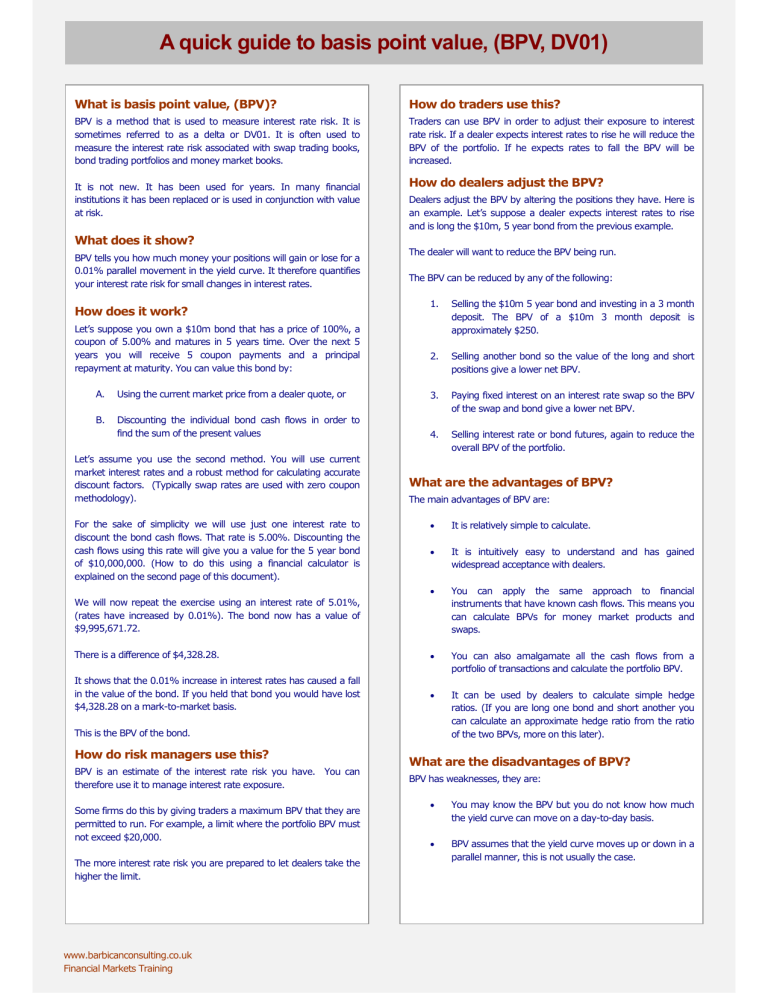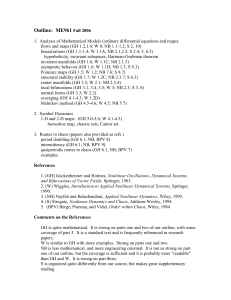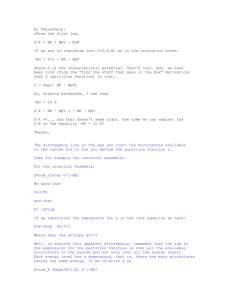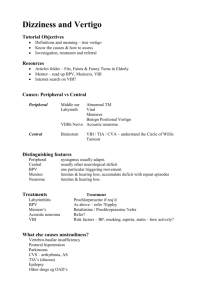
A quick guide to basis point value, (BPV, DV01) What is basis point value, (BPV)? How do traders use this? BPV is a method that is used to measure interest rate risk. It is sometimes referred to as a delta or DV01. It is often used to measure the interest rate risk associated with swap trading books, bond trading portfolios and money market books. Traders can use BPV in order to adjust their exposure to interest rate risk. If a dealer expects interest rates to rise he will reduce the BPV of the portfolio. If he expects rates to fall the BPV will be increased. It is not new. It has been used for years. In many financial institutions it has been replaced or is used in conjunction with value at risk. What does it show? BPV tells you how much money your positions will gain or lose for a 0.01% parallel movement in the yield curve. It therefore quantifies your interest rate risk for small changes in interest rates. How does it work? Let’s suppose you own a $10m bond that has a price of 100%, a coupon of 5.00% and matures in 5 years time. Over the next 5 years you will receive 5 coupon payments and a principal repayment at maturity. You can value this bond by: How do dealers adjust the BPV? Dealers adjust the BPV by altering the positions they have. Here is an example. Let’s suppose a dealer expects interest rates to rise and is long the $10m, 5 year bond from the previous example. The dealer will want to reduce the BPV being run. The BPV can be reduced by any of the following: 1. Selling the $10m 5 year bond and investing in a 3 month deposit. The BPV of a $10m 3 month deposit is approximately $250. 2. Selling another bond so the value of the long and short positions give a lower net BPV. A. Using the current market price from a dealer quote, or 3. Paying fixed interest on an interest rate swap so the BPV of the swap and bond give a lower net BPV. B. Discounting the individual bond cash flows in order to find the sum of the present values 4. Selling interest rate or bond futures, again to reduce the overall BPV of the portfolio. Let’s assume you use the second method. You will use current market interest rates and a robust method for calculating accurate discount factors. (Typically swap rates are used with zero coupon methodology). For the sake of simplicity we will use just one interest rate to discount the bond cash flows. That rate is 5.00%. Discounting the cash flows using this rate will give you a value for the 5 year bond of $10,000,000. (How to do this using a financial calculator is explained on the second page of this document). What are the advantages of BPV? The main advantages of BPV are: • It is relatively simple to calculate. • It is intuitively easy to understand and has gained widespread acceptance with dealers. • You can apply the same approach to financial instruments that have known cash flows. This means you can calculate BPVs for money market products and swaps. There is a difference of $4,328.28. • You can also amalgamate all the cash flows from a portfolio of transactions and calculate the portfolio BPV. It shows that the 0.01% increase in interest rates has caused a fall in the value of the bond. If you held that bond you would have lost $4,328.28 on a mark-to-market basis. • It can be used by dealers to calculate simple hedge ratios. (If you are long one bond and short another you can calculate an approximate hedge ratio from the ratio of the two BPVs, more on this later). We will now repeat the exercise using an interest rate of 5.01%, (rates have increased by 0.01%). The bond now has a value of $9,995,671.72. This is the BPV of the bond. How do risk managers use this? BPV is an estimate of the interest rate risk you have. You can therefore use it to manage interest rate exposure. Some firms do this by giving traders a maximum BPV that they are permitted to run. For example, a limit where the portfolio BPV must not exceed $20,000. The more interest rate risk you are prepared to let dealers take the higher the limit. www.barbicanconsulting.co.uk Financial Markets Training What are the disadvantages of BPV? BPV has weaknesses, they are: • You may know the BPV but you do not know how much the yield curve can move on a day-to-day basis. • BPV assumes that the yield curve moves up or down in a parallel manner, this is not usually the case. Can anything be done to improve BPV? Hedge ratios Yes. Firms that use BPV recognise these weaknesses and use additional risk limits. Some of these limits capture the risks that dealers have from a non-parallel shift in interest rates. Risk managers alter the shape of the yield curve. They make the yield curve steeper or flatter around a particular maturity and look at the impact that would generate on the P&L. Sometimes dealers construct trades that try to take advantage of anticipated changes in shape of the yield curve. For example they may expect short term interest rates to increase and longer term rates to fall. Many firms have moved towards statistical techniques like value at risk. This provides a probability of loss. BPV cannot do this. Here is a quick approximation for BPV In order to accurately calculate BPV you need a spreadsheet or front office trading system that provides you with precise discount factors from market interest rates. However if you want a quick approximation of basis point value the following may help, you will need a financial calculator. Suppose you want to find the BPV of a $10m, 5 year bond with a coupon of 5% when interest rates are 5%. Using the 3 year and 5 year bonds how could this trade be constructed? You sell the 3 year bond and buy the 5 year bond. Because the two bonds have different BPVs you would want to weight or ratio the trade according to their relative risks. So if you bought $10m of the 5 year bond you would sell: 4,328/2,722 (BPV 5 year/BPV 3 year )x $10m =15.9m of the 3 year bond. The BPV of the two trades would be zero. You have hedged parallel changes in the shape of the yield curve but are exposed to the non-parallel change you wanted. Input the following into your calculator: N I PMT FV = 5.00 = 5.00% = 500,000 = 10,000,000 Press PV and the calculator will give you 10,000,000 Repeat the exercise using 5.01% as the interest rate, I. The calculator now gives you $9,995,771.72 A difference of $4,328.28, the BPV of this bond And for a 3 year bond? Use the following: N I PMT FV = 3.00 = 5.00% = 500,000 = 10,000,000 Press PV and the calculator will give you 10,000,000 Repeat the exercise using 5.01% as the interest rate, I. Finally is BPV constant? No. As interest rates increase, BPV falls. You can see this if you calculate the BPV for the 5 year bond using interest rates of 10.00% and 10.01% respectively. The BPV falls from 4,328.28, (using 5.00% and 5.01%), to $3,305.71. As interest rates rise the BPV falls. Sometimes this is referred to as convexity. It can be important to traders because it can mean that the interest rate risk they have changes as interest rates move and any hedges they are using may need to be rebalanced. For risk managers this has important implications too. If you are using interest rates derived from swap rates to calculate the BPV of financial instruments and those instruments trade with credit spreads over or under swap rates then your BPV calculations will be approximations. The calculator gives you $9,997,277.26 A difference of $2,722.73, the BPV of this bond You can now see that longer dated bonds, (or swaps), give you higher BPVs and therefore greater interest rate risk. William Webster Barbican Consulting Limited Financial Markets Training wwebster@barbicanconsulting.co.uk 00 44 (0)20 79209128 www.barbicanconsulting.co.uk Financial Markets Training Copyright © 2006 by BCL All rights reserved





